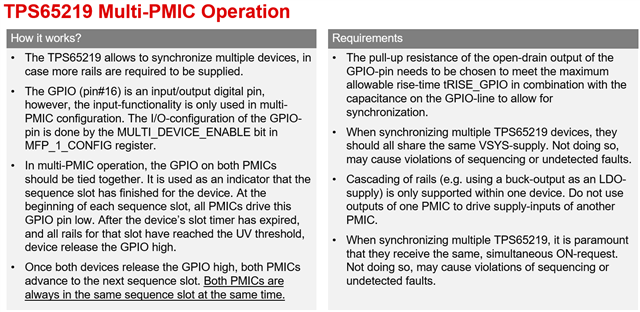Other Parts Discussed in Thread: AM623,
Currently, I am using TPS6521903 to power my AM623. Now I am studying if I am able to use the same chip to power my FPGA, PHY and other circuitry on my board. It has all the feature I need.
However, the problem I have now is that the output voltage setting of the TPS6521903 I used to power the AM623 are different than the second one I need right now for my other part of the circuit. So I cant drop it in without modification. I also want to try and avoid ordering different variant so one less internal part number to keep track of. I also don't think TI would create that config just for me(smile). So the plan is to have my microcontroller reconfigure the second PMIC, but I have a few question about doing just that.
1. From what I understood from the datasheet, I2C command can only be serviced when it is in ACTIVE mode, which also enable the output. Is there a way for me to reconfigure the PMIC without turning on the output, to avoid the default output voltage potentially cause a problem to my circuit?
2. If it is not possible to reconfigure the chip with the output turned off, could I power VSYS up first, let it go into ACTIVE and then reconfigure the chip. After reconfiguration, switch the PVIN on with a external load switch to start the voltage regulation?
3. Will the voltage setting I reconfigured return to default setting after a reset? Is there a way I can do to make my changes permanent?
4. After reconfiguration, will this chip reset and restart its power on sequence with the new voltage setting?
5. In the datasheet, there is a mention of using multiple TPS65219 together in "Multi-PMIC operation". But I can't find this section in the datasheet. Can TI tell me how multi-PMIC work with TPS65219? The I2C address of this PMIC can only be change using I2C, but how can I access to the two PMIC when they all have the same address at first turn on?
That's all the question I have right now. I may have more in the future, we can either continue here or TI representative could contact me through email (preferable).
Thanks a bunch!



